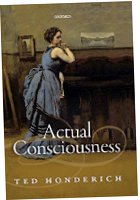Seeing and being
Preface
 This is an essay on the “hard problem” of consciousness. If we focus on visual consciousness for simplicity, this is often said to be the problem of explaining how the everyday phenomenon we call seeing “arises” from the brain. But I have never liked this way of phrasing the problem because it strikes me that we have a poor grasp (to begin with) of the everyday phenomenon of seeing itself. —What is this thing we call seeing? So, in the essay, I explore instead the prior question of what we suppose the everyday phenomenon of seeing even to be—a question just as hard, but one which I find to be considerably more fruitful. And the only decent answer I can come up with suggests that a certain form of “neutral monism” may be the true relation between mind and body. Written in 2014.
This is an essay on the “hard problem” of consciousness. If we focus on visual consciousness for simplicity, this is often said to be the problem of explaining how the everyday phenomenon we call seeing “arises” from the brain. But I have never liked this way of phrasing the problem because it strikes me that we have a poor grasp (to begin with) of the everyday phenomenon of seeing itself. —What is this thing we call seeing? So, in the essay, I explore instead the prior question of what we suppose the everyday phenomenon of seeing even to be—a question just as hard, but one which I find to be considerably more fruitful. And the only decent answer I can come up with suggests that a certain form of “neutral monism” may be the true relation between mind and body. Written in 2014.
 This is an essay on the “hard problem” of consciousness. If we focus on visual consciousness for simplicity, this is often said to be the problem of explaining how the everyday phenomenon we call seeing “arises” from the brain.
This is an essay on the “hard problem” of consciousness. If we focus on visual consciousness for simplicity, this is often said to be the problem of explaining how the everyday phenomenon we call seeing “arises” from the brain.
14. Seeing as partial being
Here’s the account so far in a nutshell.
When you see a chair (say), a certain cross-section of the chair “precipitates” for you, where this “precipitation” is a kind of “coming into existence” of the cross-section of the chair. You cannot sensibly suppose that this partial chair is the only thing that exists, but you can make sense of your situation by thinking of yourself as seeing (a part of) the chair. This is nothing more than thinking that there is “more” to reality than the part of the chair before you, i.e., that other parts of it stand also to precipitate in ways that you would typically expect to have some control over. And so, in thus introducing the notion of “seeing” the chair, you have simultaneously introduced the notion of the “being” of the chair, viz., in the phenomenalist sense described previously.
On this account, your “seeing” the chair is nothing over and above its “partial being” then for you. (These are two different labels for the same phenomenon.) The seeing is not an extra phenomenon superimposed upon – or otherwise accompanying – the partial being of the chair. Rather, a cross-section of the chair “precipitates” and this “partial being” of the chair is all that you mean when you speak of “seeing” it. The seeing is just the partial being. The notion of “partiality” is crucial here since, without it, neither the notion of seeing nor that or being would need to be invoked. (The neutral notion of the entire world “precipitating” would be all that you would need, i.e., your “state of mind” would essentially be that of an omnivisual being.)
Thinking of seeing as “partial being” may seem like a bizarre way of accommodating the diaphanousness of seeing, but I have tried to show in this essay that it is a legitimate manoeuvre. If we take the diaphanousness of seeing seriously, then, whenever you see something, “all that’s there” is whatever you then see – e.g., a part of a chair, or a part of a room, or whatever – and there is simply no extra phenomenon – the “seeing” – which is somehow “lain over” whatever you then see. This is what prompts the raw suggestion that perhaps the seeing of what you see is (somehow) just the being of what you see. The idea seems unintelligible at first sight since it appears to efface the distinction between seeing and being, but the devil is really in the ‘somehow.’
In a series of essays spanning the past decade or so, the English philosopher Ted Honderich has suggested a very similar idea, although the devil in his ‘somehow’ is somewhat different from mine. To be honest, I do not really understand his way of fleshing things out, but I do seem to understand him when he says preliminary things like this:
On my way of fleshing this out, seeing can be meaningfully identified with a “cross-section” of the physical world. (More strictly, with a cross-section that has “precipitated.”) This cross-sectional feature is non-negotiable for me, as I have emphasized numerous times, but it is no part of Honderich’s approach, so far as I can see – the “partiality” of perception does not seem to be a major theme in his account.
Honderich’s strategy, rather, is to identify seeing with something he calls a “subjective physical world”, where this stands opposed to the “objective physical world” with which we are familiar:
In any case, Honderich’s method of identifying seeing with being – whatever it comes down to – seems to be quite different from mine. This is probably also why the “phenomenalism” that is half-present in my approach is nowhere to be found in Honderich. Consider again our twin claims:
 This is all I can say with confidence here as I have yet to read Honderich’s latest book, Actual Consciousness (Oxford 2014), which is the most recent expression of his ideas. Quite generally, however, I don’t see how the “raw insight” that we share in common – viz., that seeing is (somehow) identifiable with being – can be made to work without leading ultimately to the view that seeing and being are notions that we “cleave apart” from one another, and thus notions that we “acquire together,” in the manner previously explained. This theme is also not found in Honderich, who appears to concur rather with contemporary materialists that “being” is the relatively prior notion, in terms of which “seeing” may be explained.
This is all I can say with confidence here as I have yet to read Honderich’s latest book, Actual Consciousness (Oxford 2014), which is the most recent expression of his ideas. Quite generally, however, I don’t see how the “raw insight” that we share in common – viz., that seeing is (somehow) identifiable with being – can be made to work without leading ultimately to the view that seeing and being are notions that we “cleave apart” from one another, and thus notions that we “acquire together,” in the manner previously explained. This theme is also not found in Honderich, who appears to concur rather with contemporary materialists that “being” is the relatively prior notion, in terms of which “seeing” may be explained.
Nevertheless, I hope that this brief examination of a similar-sounding view has thrown a little further light on the first claim in our pair:
Here’s the account so far in a nutshell.
When you see a chair (say), a certain cross-section of the chair “precipitates” for you, where this “precipitation” is a kind of “coming into existence” of the cross-section of the chair. You cannot sensibly suppose that this partial chair is the only thing that exists, but you can make sense of your situation by thinking of yourself as seeing (a part of) the chair. This is nothing more than thinking that there is “more” to reality than the part of the chair before you, i.e., that other parts of it stand also to precipitate in ways that you would typically expect to have some control over. And so, in thus introducing the notion of “seeing” the chair, you have simultaneously introduced the notion of the “being” of the chair, viz., in the phenomenalist sense described previously.
On this account, your “seeing” the chair is nothing over and above its “partial being” then for you. (These are two different labels for the same phenomenon.) The seeing is not an extra phenomenon superimposed upon – or otherwise accompanying – the partial being of the chair. Rather, a cross-section of the chair “precipitates” and this “partial being” of the chair is all that you mean when you speak of “seeing” it. The seeing is just the partial being. The notion of “partiality” is crucial here since, without it, neither the notion of seeing nor that or being would need to be invoked. (The neutral notion of the entire world “precipitating” would be all that you would need, i.e., your “state of mind” would essentially be that of an omnivisual being.)
Thinking of seeing as “partial being” may seem like a bizarre way of accommodating the diaphanousness of seeing, but I have tried to show in this essay that it is a legitimate manoeuvre. If we take the diaphanousness of seeing seriously, then, whenever you see something, “all that’s there” is whatever you then see – e.g., a part of a chair, or a part of a room, or whatever – and there is simply no extra phenomenon – the “seeing” – which is somehow “lain over” whatever you then see. This is what prompts the raw suggestion that perhaps the seeing of what you see is (somehow) just the being of what you see. The idea seems unintelligible at first sight since it appears to efface the distinction between seeing and being, but the devil is really in the ‘somehow.’
In a series of essays spanning the past decade or so, the English philosopher Ted Honderich has suggested a very similar idea, although the devil in his ‘somehow’ is somewhat different from mine. To be honest, I do not really understand his way of fleshing things out, but I do seem to understand him when he says preliminary things like this:
This strikes me as being the same raw suggestion that the seeing of what you see is (somehow) just the being of what you see, as I put it above. Honderich’s account of the devilish ‘somehow’ has changed over the years, and is not particularly easy to pin down, but the “raw suggestion” itself is something that he has consistently maintained for quite a while. Here’s a decade-earlier expression of it:I sat in a room some years ago and said to myself stop reading all this madly conflicting stuff about consciousness. You’re conscious. This isn’t Quantum Theory, let alone the bafflement of moral and political truth. Just answer the question of what your being conscious right now is, or more particularly what your being conscious of the room is, conscious in just seeing the room. Not thinking about just seeing. Not liking it or whatever. You know the answer in some sense, don’t you? You’ve got the hold.The answer in my case, lucky or unlucky, was that my being conscious was the fact of the room being there, just the room being there. Later on, as you will be hearing, I preferred to say that a room was being there. (‘Actualism: A Different Theory of Consciousness,’ section 3.)
As before, this looks like gibberish at first, but I pointed out previously that it is really just the converse of the broad idealist suggestion that the world is a bundle of sense experiences. As such, it can hardly be gibberish. Honderich himself seems to agree:What is it for you now to be aware of your surroundings? It’s for things somehow to exist, isn’t it? To speak a little grandly, what it is for you to be perceptually conscious now is for a world somehow to exist, a certain changing totality of things. Mine now consists in things in this room and outside the window. This seems to be the right answer to the question of the so-called phenomenology or seeming nature or appearance of perceptual consciousness. Something more is worth thinking about – that we here have the most promising conception of actual perceptual consciousness, that we here begin to get hold of its real nature. What it is for you to be aware of your surroundings is for, in a certain sense, there to be certain things with various properties in space and time. (‘Consciousness as Existence Again,’ section 1.)
So I seem to have stumbled upon the same “insight” as Honderich has – if we can call it that – viz., that there may be a way (somehow) of identifying seeing with being; of identifying perceptual consciousness with the external world.If you fancy aphorisms, you can also say about perceptual consciousness Berkeley wasn’t near to right in saying esse est percipi, to be is to be perceived. The better aphorism is to be perceptually conscious is for something in a way to be. (‘Actualism: A Different Theory of Consciousness,’ section 8.)
On my way of fleshing this out, seeing can be meaningfully identified with a “cross-section” of the physical world. (More strictly, with a cross-section that has “precipitated.”) This cross-sectional feature is non-negotiable for me, as I have emphasized numerous times, but it is no part of Honderich’s approach, so far as I can see – the “partiality” of perception does not seem to be a major theme in his account.
Honderich’s strategy, rather, is to identify seeing with something he calls a “subjective physical world”, where this stands opposed to the “objective physical world” with which we are familiar:
This distinction between “subjective” and “objective” physicality is not one that I feel I understand, however, nor is such a distinction needed in my approach. Indeed, my first impression is that the notion of “subjectivity” smuggles in by the back door the very sort of phenomenon we were trying to account for. (But this is just a first impression.)So my being perceptually conscious now is the existence of a part or piece or stage of a sequence that is one subjective physical world, one among very many, as many as there are sets of perceivings of single perceivers. These myriad worlds are no less real for there being myriads of them and for their parts being more transitory than parts of the objective physical world. Myriad and momentary things in the objective physical world do not fail to exist on account of being myriad and momentary. (‘Actualism: A Different Theory of Consciousness,’ section 8.)
In any case, Honderich’s method of identifying seeing with being – whatever it comes down to – seems to be quite different from mine. This is probably also why the “phenomenalism” that is half-present in my approach is nowhere to be found in Honderich. Consider again our twin claims:
Seeing is (precipitated) partial being;
Being is potential seeing.
The first claim is my way of identifying seeing with being, and I have also explained why, on this approach, the second “phenomenalist” claim is a necessary accompaniment. No such idea is present in Honderich’s writings. He seems content to endorse a version of the first claim alone, expressing it roughly as follows, I would think:Being is potential seeing.
Seeing is subjective being.
This is his way of identifying seeing with being, and also what I meant at the end of the previous section when I said that it was theoretically possible to endorse some version of the first claim alone and “drop” the phenomenalist sister-claim altogether. So far as I can make out, Honderich means to occupy this position, and occasionally refers to it as a “radical externalism.” It is a way of reducing seeing to being that departs sharply from familiar materialist approaches that attempt to reduce seeing to physical happenings within the head.
Nevertheless, I hope that this brief examination of a similar-sounding view has thrown a little further light on the first claim in our pair:
Seeing is (precipitated) partial being;
Being is potential seeing;
which is indeed the “bizarre” claim, when compared with the second phenomenalist claim, which is historically more familiar. And so the first claim really does deserve the lion’s share of the discussion. In any case, this pair of claims constitutes the broad position of this essay and I would like to end by explaining what “further work” I think needs to be done. The notion of a “precipitation,” in particular, is liable still to seem mysterious and I’d like to express some final thoughts on this, among other things.
Being is potential seeing;
Menu
 What’s a logical paradox?
What’s a logical paradox? Achilles & the tortoise
Achilles & the tortoise The surprise exam
The surprise exam Newcomb’s problem
Newcomb’s problem Newcomb’s problem (sassy version)
Newcomb’s problem (sassy version) Seeing and being
Seeing and being Logic test!
Logic test! Philosophers say the strangest things
Philosophers say the strangest things Favourite puzzles
Favourite puzzles Books on consciousness
Books on consciousness Philosophy videos
Philosophy videos Phinteresting
Phinteresting Philosopher biographies
Philosopher biographies Philosopher birthdays
Philosopher birthdays Draft
Draftbarang 2009-2024  wayback machine
wayback machine
 wayback machine
wayback machine





